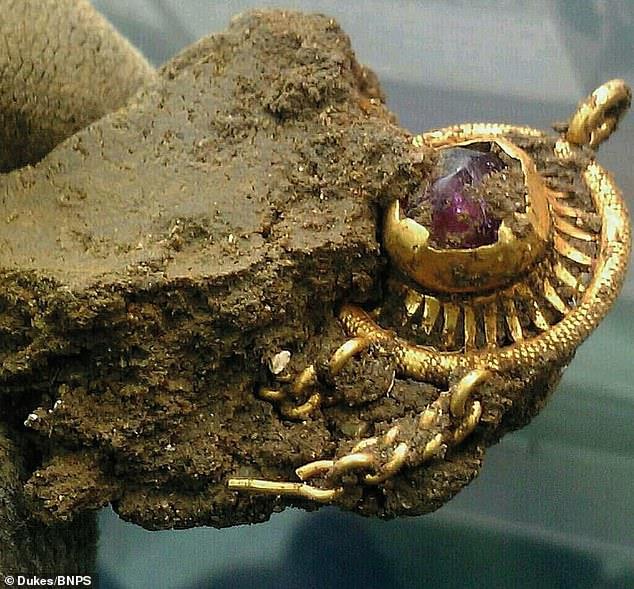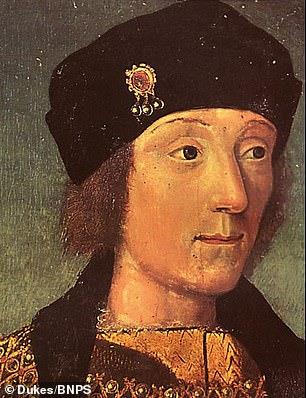






Looking After Your Finds - Rings

Medievil Period - Identification
Powered By Sispro1

Jewellery
Copyright All Rights Reserved by Nigel G Wilcox E-Mail: ngwilcox100@gmail.com
Designed by Nigel G Wilcox
Complimentary Topics
The Paragon Of Metal Detecting
& Archaeology
& Archaeology
Metal detectorist unearths stunning 15,000 gold hat pin from 1485 which may have belonged to King Edward IV
Courtesy: Victoria Bell for Mailonline: 11 April 2019. Updated for paragon publications 13 April 2019
Pages
More Successful Finds >>>
-Metal detectorist Lisa Grace spotted the Medieval jewel in freshly-ploughed field
-It is believed that the piece is linked to Edward IV, who lived from 1442 - 1483
-Specialists speculate that the piece may have been lost in battle in the area
-The King wore strikingly similar pieces and is designed as a sun in splendour - the personal
emblem of Edward IV
-It is believed that the piece is linked to Edward IV, who lived from 1442 - 1483
-Specialists speculate that the piece may have been lost in battle in the area
-The King wore strikingly similar pieces and is designed as a sun in splendour - the personal
emblem of Edward IV
An amateur metal detectorist has unearthed a gold hat pin worth £15,000 that may have belonged to King Edward IV, who reigned during the 15th century.
Lisa Grace, 42, spotted the Medieval jewel, which is in pristine condition, while searching a recently-ploughed field in Lincolnshire.
It is believed the pin is linked to royalty as Edward IV and his circle wore strikingly similar pieces during his two reigns as King from 1460 until his death in 1483.
Experts believe that the jewel was made in the late 15th century and is designed as a sun in splendour - the personal emblem of Edward IV.
They believe that the piece may have been lost in battle. His first reign was filled with power struggle and conflicts, with many taking place in the area.
Lisa Grace, 42, spotted the Medieval jewel, which is in pristine condition, while searching a recently-ploughed field in Lincolnshire.
It is believed the pin is linked to royalty as Edward IV and his circle wore strikingly similar pieces during his two reigns as King from 1460 until his death in 1483.
Experts believe that the jewel was made in the late 15th century and is designed as a sun in splendour - the personal emblem of Edward IV.
They believe that the piece may have been lost in battle. His first reign was filled with power struggle and conflicts, with many taking place in the area.

A metal detectorist has unearthed a gold hat pin that may have links to King Edward IV and is worth £15,000. Lisa Grace spotted the Medieval jewel while searching a recently-ploughed field in Lincolnshire
At the centre of the piece is a purple amethyst stone, another of the King's favourites, leading some specialists to speculate that it may have been lost by Edward IV himself.
The pin closely resembles a very similar jewel depicted on Edward IV's hat in a portrait preserved in The Museum Calvet in Avignon, France.
Ms Grace said she was stunned when she found it a few inches below the ground.
'When I found it the jewel wasn't far under the ground at all as the field had recently been ploughed,' she said.
The pin closely resembles a very similar jewel depicted on Edward IV's hat in a portrait preserved in The Museum Calvet in Avignon, France.
Ms Grace said she was stunned when she found it a few inches below the ground.
'When I found it the jewel wasn't far under the ground at all as the field had recently been ploughed,' she said.


Lisa Grace, left, spotted the pristine jewel in a recently-ploughed field in Lincolnshire, Right, Edward IV and his circle wore strikingly similar pieces in the 15th century

The jewel is thought to have been made around the year 1485 and is designed as a sun in splendour - the personal emblem of Edward IV. At the centre of the piece is a purple amethyst stone, another of the King's favourites, leading some specialists to speculate that it may have been lost by Edward IV himself.
The specialists say they have been experiencing early interest from both collectors and museums and are expecting offers between 10,000 and 15,000.
Mr Schwinge from Duke's, said: 'The jewel does bear a striking resemblance to the one in a well-known portrait of Edward IV from the Musee Calvet.
He also said that it also could have belonged to a courtier.
'The fact is we shall never know but it clearly belonged to someone of high status in the upper echelons of medieval society.'
The possibility that it could have belonged to royalty is amazing and even if it didn't, it would have belonged to someone of high status.'
Ms Grace has now listed the pin for sale and it is to go under the hammer at Duke's Auctioneers of Dorchester, Dorset.
The jewel, which remains in stunning condition, will be sold at the auction house on April 26.
The specialists say they have been experiencing early interest from both collectors and museums and are expecting offers between 10,000 and 15,000.
Mr Schwinge from Duke's, said: 'The jewel does bear a striking resemblance to the one in a well-known portrait of Edward IV from the Musee Calvet.
He also said that it also could have belonged to a courtier.
'The fact is we shall never know but it clearly belonged to someone of high status in the upper echelons of medieval society.'
The possibility that it could have belonged to royalty is amazing and even if it didn't, it would have belonged to someone of high status.'
Ms Grace has now listed the pin for sale and it is to go under the hammer at Duke's Auctioneers of Dorchester, Dorset.
The jewel, which remains in stunning condition, will be sold at the auction house on April 26.


WHO WAS EDWARD IV?
Edward IV was twice king of England during his lifetime and lived from (1442 - 1483). He is the older brother of Richard III.
He was born on 28 April 1442 at Rouen in France, the son of Richard Plantagenet, Duke of York.
Edward's father the third Duke of York lead the dynastic struggle against the Lancastrians known as the Wars of the Roses, which began in 1455.
After he was killed at the Battle of Wakefield in 1460, Edward inherited his claim.
With the support of the powerful Earl of Warwick, Edward defeated the Lancastrians in a series of battles.
With the Lancastrian king, Henry VI, overthrown, Edward was crowned Edward IV.
Warwick believed he could continue to control the new king. He was keen to negotiate a foreign marriage for Edward, but in 1464 Edward secretly married Elizabeth Woodville, a commoner.
Warwick was furious, leading a revolt against the king. Warwick and Clarence then fled to France, where they joined Margaret of Anjou, wife of Henry VI.
Margaret's Lancastrian army invaded England in September 1470. Edward fled to the Netherlands until March 1471, when he and his brother Richard, Duke of Gloucester, returned to England.
Edward defeated and killed Warwick at Barnet before defeating the Lancastrians at Tewkesbury in May.
Henry VI was put to death in the Tower of London.
The second part of Edward's reign, from 1471 to 1483, was a period of relative peace and security.
He used income from the Crown Estates to pay governmental costs, and was therefore less in need of parliamentary grants than his predecessors - he called parliament only six times.
Edward died on 9 April 1483. His young sons, Edward and Richard, were left in the protection of their uncle Richard, Duke of Gloucester.
Richard housed them in the Tower of London where they were probably murdered on his orders.
Parliament requested that Richard take the throne and he accepted, being crowned Richard III.
Edward IV was twice king of England during his lifetime and lived from (1442 - 1483). He is the older brother of Richard III.
He was born on 28 April 1442 at Rouen in France, the son of Richard Plantagenet, Duke of York.
Edward's father the third Duke of York lead the dynastic struggle against the Lancastrians known as the Wars of the Roses, which began in 1455.
After he was killed at the Battle of Wakefield in 1460, Edward inherited his claim.
With the support of the powerful Earl of Warwick, Edward defeated the Lancastrians in a series of battles.
With the Lancastrian king, Henry VI, overthrown, Edward was crowned Edward IV.
Warwick believed he could continue to control the new king. He was keen to negotiate a foreign marriage for Edward, but in 1464 Edward secretly married Elizabeth Woodville, a commoner.
Warwick was furious, leading a revolt against the king. Warwick and Clarence then fled to France, where they joined Margaret of Anjou, wife of Henry VI.
Margaret's Lancastrian army invaded England in September 1470. Edward fled to the Netherlands until March 1471, when he and his brother Richard, Duke of Gloucester, returned to England.
Edward defeated and killed Warwick at Barnet before defeating the Lancastrians at Tewkesbury in May.
Henry VI was put to death in the Tower of London.
The second part of Edward's reign, from 1471 to 1483, was a period of relative peace and security.
He used income from the Crown Estates to pay governmental costs, and was therefore less in need of parliamentary grants than his predecessors - he called parliament only six times.
Edward died on 9 April 1483. His young sons, Edward and Richard, were left in the protection of their uncle Richard, Duke of Gloucester.
Richard housed them in the Tower of London where they were probably murdered on his orders.
Parliament requested that Richard take the throne and he accepted, being crowned Richard III.
Main Coin Menu
Member NCMD
Specialised. Menu





















